General Insurance Blogs, Articles & Updates by - Magma HDI
Have us call you
- RENEW YOUR POLICY
- BUY NEW POLICY

Can depression be genetic? Let's discuss
As healthcare and mental health awareness continue to grow, the question of whether depression can be genetic has become more prevalent. Depression is a debilitating mental illness affecting millions worldwide and can be challenging to diagnose and treat. While various factors can contribute to the development of depression, including environmental and social factors, the role of genetics in the condition has been a subject of research for many years. Understanding the genetics of depression and its impact on mental health is crucial to providing appropriate care and treatment for those who need it.
We'll also understand the importance of early detection and treatment and how health insurance policies can play a vital role in curing depression. Let's get started!
1. Understanding depression
Depression is a complex mental illness that can manifest in various ways, including feelings of sadness, hopelessness, and despair. While it is a common mental health condition, depression can be challenging to diagnose and treat due to the wide range of symptoms that can be present.
2. The genetic component of depression
Research has shown a genetic component to depression, confirming that it can run in families. Studies have found that people with a family history of depression will likely develop the condition. It is advisable to consult a doctor and get routine tests done.
3. Other influencing factors in depression
While genetics play a role in depression, it is not the only factor contributing to the condition's development. Environmental components, such as stress, trauma, and life events, also significantly impact your mental health.
4. The genetics of depression: What we know so far
There is still much to learn about the genetics of depression, but researchers have made some significant strides in recent years. Studies have identified several genes that may be involved in the development of depression, including those that regulate serotonin and other neurotransmitters in the brain.
5. The importance of early diagnosis and treatment
Whether depression is genetic or not, early detection and treatment are critical to managing the condition effectively. People who are at risk of developing depression due to their family history should be screened regularly and should seek treatment if they begin to experience symptoms.
6. The role of health insurance in depression treatment
For many people, the cost of depression treatment can be a significant barrier to accessing proper care. Health insurance policies can help to mitigate these costs by covering the cost of therapy, medications, and other treatments.
7. Health insurance policy renewal and mental health coverage
When it comes time to renew your health insurance policy, reviewing your coverage for mental health treatment is essential. Ensure that your policy covers the cost of therapy and medications for mental health treatment or if there are some deductibles you may be responsible for.
8. The importance of spreading awareness about mental health coverage
If your health insurance policy does not provide adequate coverage for mental health treatment, it is essential to speak up for better coverage. Contact your insurance provider or speak to your employer's benefits department to discuss your options and work to improve your coverage.
In conclusion, depression can be a complex and challenging condition to manage, but with early detection and treatment, it is possible to live a fulfilling life. While genetics play a role in the development of depression, environmental factors, and other influences can also contribute to the condition's onset. Health insurance policies can help to make depression treatment more accessible and affordable. However, verify all the policy features at the time of health insurance policy renewal. Working together can improve mental health care and help more people get the support and treatment they need to thrive.
Click HERE to learn more about your health insurance policy renewal and how to do it quickly.
Disclaimer: The information provided above is for illustrative purposes only. To get more details, please refer to policy wordings and prospectus before purchasing a policy.

The hidden indicators in your blood test report you might not be aware of
Healthcare professionals frequently utilise blood tests to identify and track a range of medical disorders. A blood test is a medical process in which a medical professional takes a sample of a patient's blood. Then the sample is examined in a lab to measure different chemicals in the blood. Blood test costs are frequently covered as part of health insurance plans in India. Depending on your chosen insurance plan, the scope of coverage and the particular blood tests covered may differ.
It would be best if you were made aware of the significance of several hidden indicators which can provide important details about your general health and assist in detecting future health issues.
1. Vitamin D
Vitamin D helps immune health, bone health, and other bodily functions. Numerous health issues, including osteoporosis, depression, and an elevated risk of several malignancies, can be brought on by low vitamin D levels. People who reside in places with little sun exposure are more likely to have vitamin D deficiencies.
2. Thyroid hormones
The thyroid gland releases hormones that regulate the body's metabolism and production of energy. Fatigue, weight gain, and depression are just a few health issues that are caused due to low thyroid hormone levels. Other causes of thyroid abnormalities include autoimmune diseases and radiation exposure.
3. C-reactive protein (CRP)
C-reactive protein (CRP) is produced in the body in response to inflammation. Increased CRP levels can signify several medical conditions, including infections, autoimmune diseases, etc. Cancer, diabetes, and arthritis are a few examples of chronic diseases that can be contributed to inflammation in the body.
4. Triglycerides
Blood contains a specific kind of fat called triglycerides. Cardiovascular disease risk is enhanced by having high triglyceride levels. Obesity, a high-carbohydrate diet, and particular medications are just a few of the things that might raise triglycerides.
5. White blood cells
White blood cells are a specific type of blood cell that aids in the body's defence against illness and infection. Abnormal white blood cell counts can indicate a disease such as leukaemia and autoimmune disorder which can weaken bodily function and be life-threatening.
6. Iron
An essential ingredient called iron is required for the production of haemoglobin. This protein is found in red blood cells that transport oxygen throughout the body. Anaemia is the condition when the body produces insufficient red blood cells, and low iron levels can cause it. In addition to other symptoms, anaemia can make you tired and worn out.
7. Homocysteine
Homocysteine is an amino acid produced during the metabolism of methionine, an essential amino acid. Elevated homocysteine levels are linked to a higher risk of cardiovascular disease, stroke, and Alzheimer's.
8. HbA1c
Diabetes is diagnosed and managed using the HbA1c blood sugar control indicator. The risk of consequences like kidney damage, nerve damage, and cardiovascular disease can increase when HbA1c values rise because they signify poor blood sugar control.
9. Creatinine
Creatinine is a waste product filtered out of the body by the kidneys and produced by muscle metabolism. Several symptoms, including fatigue, fluid retention, and high blood pressure, can be caused by elevated creatinine levels. Elevated levels of creatinine can be an indication of kidney damage or injury.
An individual's health status can be determined a lot by blood tests. In addition, there are a lot of hidden indicators in these tests that can reveal important information about your health conditions. Discussing blood reports with your healthcare professional is essential to understand your overall well-being. The cost of diagnostic testing, including blood tests, can be covered under health insurance plans in India. These plans could be excellent for people who want frequent check-ups to monitor their health status. It is always advisable to verify all the terms with your insurer and do thorough research before purchasing health insurance plans in India.
Click HERE to browse different health insurance plans in India.
Disclaimer: The information provided above is for illustrative purposes only. To get more details, please refer to policy wordings and prospectus before purchasing a policy.

The power of positive thinking: How to develop a growth mindset for success
Our way of thinking and approach to life significantly impact our success and well-being. The growth mindset, or the power of positive thinking, is a well-known concept that has gained widespread recognition in recent years. This mindset emphasises that we can develop our abilities and intelligence through hard work, dedication, and a positive attitude. Here, we will explore the power of positive thinking and how to develop a growth mindset for success.
What is a growth mindset?
The term "growth mindset" was coined by a well-known psychologist and researcher, Carol Dweck. A growth mindset defines that one's abilities can be developed and polished through hard work and perseverance. People with a growth mindset view challenges and failures as opportunities for growth and steer themselves out by making strong comebacks to achieve their goals. In contrast, people with fixed mindsets believe their abilities and intelligence are predetermined and cannot be changed. They shy away from hardships and give up easily when faced with challenges.
The power of positive thinking
Positive thinking is a crucial component of developing a growth mindset. It involves focusing on the positive aspects of a situation and looking for opportunities to learn and grow. Positive thinking can help develop a growth mindset by:
● Changing your perspective: Approaching challenges and failures with a positive mindset enables you to view them as opportunities for growth. You can learn valuable lessons from the experiences and avoid the thoughts that demotivate you.
● Increasing resilience: Positive thinking helps to develop resilience or the ability to recover from adversity. Focusing on the positive aspects of a situation equips you to tackle problems and endure difficult times.
● Boosting confidence: Positive thinking helps to boost your confidence and self-esteem. When you believe you can shine your abilities and overcome hurdles with a passionate intent, you're more likely to take risks and accomplish your goals.
How to develop a growth mindset?
Developing a growth mindset requires time and effort, but it's worth it. Following are a few ways to develop a growth mindset:
● Embrace challenges: It is the best thing to do to make growth chase you. Seek out challenges rather than running away from them. Every new challenge gives you a new experience that shapes your skills and confidence to improve.
● Learn from failures: When you experience failures or setbacks, reflect on what you can learn from those experiences. Consider what you could have done differently and how to improve next time.
● Cultivate a positive mindset: Focus on the positive aspects of a situation and look for opportunities that promise you contentment. Practice gratitude, positive self-talk, interact with positive people, and consume motivational content to help shift your mindset to a more positive outlook.
● Emphasise effort over talent: You're more likely to succeed when you work hard and put in the effort. Be consistent with what you do and continue to work hard unless you achieve your objectives.
A positive mindset is essential when caring for our health and well-being. By maintaining a positive outlook, we can stay motivated to lead a healthy lifestyle, seek the best healthcare options, and take steps to prevent illness and disease. Similarly, developing a growth mindset can help us stay motivated to achieve our goals and overcome challenges related to our health.
Choosing the best health insurance in India is just one of the many steps to ensure we care for ourselves and our loved ones in the best way possible. The power of positive thinking and the growth mindset can profoundly impact your success and happiness. By accepting challenges, learning from failures, and cultivating a positive mindset, you can develop the skills and abilities needed to be successful. Developing a growth mindset takes time and effort, but you can achieve great things with dedication and hard work.
Click HERE to buy the best health insurance in India.
Disclaimer: The information provided above is for illustrative purposes only. To get more details, please refer to policy wordings and prospectus before purchasing a policy.
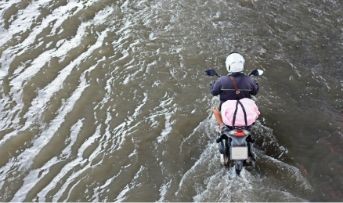
The complete guide for bike safety during floods
Biking is a well-liked form of exercise and transportation, but it may also be dangerous when floods occur. One of the natural calamities that occur most frequently worldwide is flooding. As a result, the nation suffers severe socio-economic losses. Floodwaters can cause highway disasters, create dangerous situations, and increase the risk of electrocution. You can, however, ride your bike safely during floods if you take the proper safety measures.
Even though caution can significantly lower the chance of accidents and injuries when biking through floods, unexpected events can still occur. Bike insurance offers financial security and peace of mind in such circumstances. Here's a detailed guide to biking safely during floods.
1. Plan your route
It's essential to consider regions prone to flooding, such as low-lying areas, riverbanks, and bridges, while planning your motorcycling route during a flood. Always stay on high ground and avoid these regions. Plan a path that stays clear of the flooded areas using online maps.
2. Use lights
Motorcycle lights make you more visible to other drivers when it's dark or low light. Ensure that your bike has lights and reflectors. It would help if you also considered bringing a tiny torch or headlamp in an emergency.
3. Stay informed
It's essential to be aware of local conditions before riding a bike during a flood. If there are flood warnings or advisories, keep an eye on local weather forecasts and news updates to stay informed. Avoid riding in regions with flood warnings or advisories and take a different route.
4. Wear appropriate gear
You must wear appropriate clothing to protect yourself from the rain and water when riding through a flood. Put on a waterproof jacket and a pair of trousers to keep dry. Ensure that your shoes are water-resistant as well. Wearing reflective clothing or gear can improve your visibility to other drivers.
5. Slow down
Riding in flooded regions requires extra caution and slowing down. Floodwaters may be deeper than they appear and may cover trash or other obstructions. To avoid any unforeseen dangers, slow down.
6. Watch out for dangers
Be cautious when riding through floodwaters to avoid obstacles like downed trees, electricity lines, and perhaps washed-in debris. Avoid these risks whenever possible. If you encounter a downed power line, maintain a distance of at least 10 feet and contact your local power company immediately.
7. Follow the guidance of authorities
It's essential to follow the advice of emergency officials and local authorities during a flood. Road closures and evacuation orders may be included in this. Consult with local authorities first if you are unsure whether riding in a particular location is safe.
8. Stay on marked bike paths
Stick to marked riding paths or roads that are open and safe for commuting. Avoid any areas that are closed off or that the authorities have blocked. When a road is closed, or a diversion is indicated, follow the instructions on the sign.
9. Avoid fast-moving water
Avoid riding your bike across the moving water since it might easily knock you off and take you with it. If you must ride your bike through the water to cross a flooded area, walk your bike instead. Remember that riding a motorcycle through even a few inches of water can be fatal.
Additional safety measures and close attention to detail are needed when biking during a flood. You can safeguard your safety when biking through floods by carefully planning your route and following official guidance. Remember, it's always better to avoid biking in dangerous conditions whenever possible. Bike insurance can offer significant financial protection in unforeseen circumstances like floods or other conditions. Review your policy carefully and take the appropriate safety measures to safeguard you and your bike.
Click HERE to invest in the bike insurance policy.
Disclaimer: The information provided above is for illustrative purposes only. To get more details, please refer to policy wordings and prospectus before purchasing a policy.
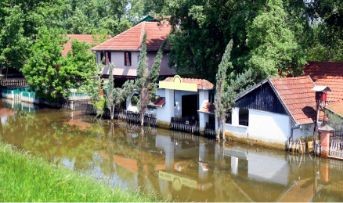
Here are some ways to ensure the protection of your dear ones and assets from flood
Floods are natural disasters that can happen unexpectedly, causing damage to property and putting lives in danger. Even while you can't always stop a flood from occurring, there are precautions you can take to safeguard yourself and your property from damage.
Personal accident insurance India does offer protection in an accident that leaves someone injured or dead. But buying a separate flood insurance policy to protect yourself and your property from flood damage will be ideal. Typically, this policy will cover flooding-related harm to your house, assets, and other property.
Let's look at a few guidelines to protect your loved ones and assets against flooding:
1. Know your risk
The first step in preventing floods from harming you and your belongings is to become aware of your area's flood risk. The likelihood of flooding varies from place to place depending on geography, elevation, and proximity to water sources. Consult the Flood Map Service Centre to determine your flood risk. You can contact your local government or emergency management office to learn about flood dangers.
2. Buy flood insurance
Getting flood insurance is one of the most crucial things you can take to safeguard your home against flood damage. You'll need a particular flood insurance policy to protect your property since standard homeowner's insurance sometimes doesn't cover flood damage. The National Flood Insurance Programme (NFIP) and private insurers offer flood insurance. It's important to carefully read your policy to understand what it covers and how much insurance you have.
3. Elevate your property
Consider elevating your home if you live in a flood-prone location to reduce the chance of heavy damage. Raising your house or property above flood level is called promoting it. It can be accomplished in many ways, including constructing a raised foundation or adding stilts or piers. You can reduce the cost of your flood insurance by elevating your home.
4. Safeguard important documents
Important papers, including insurance policies, forms of identification, etc., should be kept in a secure location in case of a flood. Store these documents in a position that won't likely be affected by flooding. Store them in a waterproof container, like a safe or waterproof bag. You can also make digital copies of your key documents and store them safely online or on a portable hard drive.
5. Install flood-barriers
By keeping water from entering your home, flood barriers can help safeguard your property against flood damage. Sandbags are typical flood barriers to build a wall against flood waters around your home. Another form of flood barrier that is quick and simple to install is a water-filled barrier. Levees or other permanent flood barriers can also be implemented, offering long-term protection against flood damage.
6. Stay informed
You can prepare for a flood and reduce the risk of damage by staying updated about flood alerts and advisories. You can sign up for alerts from emergency management agencies and follow local weather reports online. Follow local officials' advice and vacate the place if a flood warning is issued for your area.
7. Have an emergency plan
You and your family can stay safe in the case of a flood if you have an emergency plan in place. Your emergency plan should contain escape routes, emergency contacts, and a list of things you must take while leaving. To ensure everyone is prepared, practise your emergency plan with your family.
Protecting you and your property against flooding is essential to reduce damage and safeguard your well-being. By looking at flood maps and learning about the local flood history, you can estimate the risk of flooding. Additionally, an emergency plan should be created that details evacuation routes, contact options, and emergency supplies. In addition to personal accident insurance India, buy a separate flood insurance policy to protect assets from the flood.
Click HERE to buy a reliable personal accident insurance India policy.
Disclaimer: The information provided above is for illustrative purposes only. To get more details, please refer to policy wordings and prospectus before purchasing a policy.
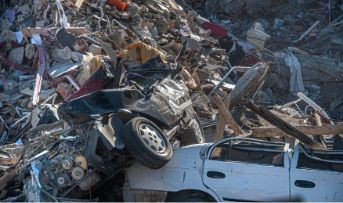
Complete guide to ensure the safety of your car during an earthquake
As natural catastrophes become more frequent and severe, safeguards are critical to keeping our vehicles safe. As car owners, we put a lot of time and money into buying and maintaining our automobiles. Therefore, we must protect them against disasters like earthquakes. Not only earthquake damages are expensive to fix, but they can also jeopardise your and your family's safety. In this article, we will go through a complete guide to ensure the safety of your car during an earthquake. We will review detailed points to protect your vehicle and yourself from potential earthquake damage.
In addition, we will discuss the significance of online car insurance and how it can assist in protecting you financially in the event of earthquake damage. Following these tips may make your car as safe as possible during an earthquake and be better prepared for future natural disasters. Let's get started.
1. Select a secure parking spot
Choosing a safe parking area is critical to ensuring your car's safety during an earthquake. Avoid parking in places prone to landslides or with many trees that could fall on your vehicle. Look for parking spaces in open areas away from buildings and trees, such as parking lots. Additionally, attempt to position your car facing outwards so you may quickly evacuate in an emergency.
2. Safeguard your vehicle
When an earthquake strikes, your car may shake severely, and anything inside may become lethal projectiles. As a result, it's always advisable to keep your car's contents intact and unloose. Protect any unsecured goods inside your vehicle, such as computers, luggage, and other items. Additionally, ensure that your car is in good shape and that all parts, including wheels and tyres, are securely fastened.
3. Keep valuable documents safe
Maintaining your car insurance documents, registration papers, and other important documents is required in a secure location. Always keep them in a waterproof and fireproof container in your car or a safe place at home. Keep a digital copy of your documents on your phone or other digital devices.
4. Check your online car insurance protection
Earthquakes can cause severe damage to your vehicle, so ensure your car insurance is updated. Verify your online car insurance policy covers earthquake damage. Also, be sure you understand what your insurance policy covers and what it does not.
5. Prepare an emergency kit
During an earthquake, having an emergency pack in your car is critical. A first-aid kit, a torch, a blanket, a map, and a portable charger should all be included in the kit. You can also have some non-perishable food and drink.
6. Stay in your car
During an earthquake, remain inside your vehicle and fasten your seatbelt until the shaking stops. If you're driving, pull over to a safe location, turn off the engine, and remain inside your vehicle until the shaking stops.
7. Be cautious after the earthquake
Drive with caution after the earthquake. Examine your vehicle for any apparent damage, such as dents, scrapes, or shattered windows. If you fear that your car has suffered substantial damage, wait to drive it until a specialist has inspected it.
8. Prepare for future earthquakes
Earthquakes can occur anytime, and preparing for future quakes is critical. Keep your car in good shape and regularly serviced to guarantee its functioning. Consider adding safety measures, such as a GPS tracker, an alarm system, or a dashcam, to protect your vehicle in the event of damage.
In conclusion, securing the safety of your vehicle during an earthquake is critical. The above safety tips can help safeguard your car from harm during an earthquake. Protect yourself and your family by adequately preparing and caring for your vehicle during an earthquake. You can explore all the insurance options available from the convenience of your home and purchase online car insurance that caters to your needs in the best ways possible. Remember that safety comes first, and taking precautions now might save you a lot of trouble later.
Click HERE to learn more about purchasing online car insurance and its benefits.
Disclaimer: The information provided above is for illustrative purposes only. To get more details, please refer to policy wordings and prospectus before purchasing a policy.
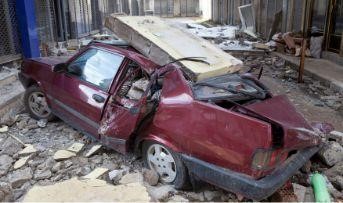
The future of car insurance coverage for earthquakes in India: Trends and innovations
The frequency and intensity of earthquakes have grown in recent years, inflicting property damage, including car damage. Car owners are required by law to carry car insurance, and as a result, insurance policies are expanding to cover earthquake damage. The future of automobile insurance coverage for earthquakes in India is a critical issue that impacts both car owners and insurance providers.
In this space, we will look at the various types of coverage available, the role of technology, and how car owners may guarantee their vehicles the best coverage in the case of an earthquake. Let's begin!
1. Increase in natural disasters
Natural disasters such as earthquakes have become more common in India. Since India has been witnessing more earthquakes with magnitudes greater than 3.0 recently, car owners must have insurance coverage to safeguard their valuable assets against the adversities of an earthquake.
2. Comprehensive car insurance
Comprehensive car insurance protects your car against natural disasters such as earthquakes. It differs from a third-party liability policy, which solely covers damages to a third party in the event of an accident. Car owners should think about getting comprehensive car insurance that covers earthquake damage.
3. Earthquake coverage add-ons
Aside from comprehensive insurance, vehicle insurance companies often provide add-ons to cover specific natural disasters such as earthquakes. The optional features include engine protection, roadside assistance, and 0% depreciation. Car owners should consider obtaining these add-ons to supplement their coverage.
4. Usage-based car insurance
In India, usage-based automobile insurance coverage is becoming more common. These policies base premiums on vehicle usage, and the car owners who drive their vehicles less frequently pay a lower rate. In the future, usage-based automobile insurance policies can be tailored to provide earthquake coverage based on the vehicle's geographical location.
5. Telematics
Telematics uses technology to monitor a vehicle's performance and usage. In the future, automobile insurance companies may utilise telematics to track the car's location and provide coverage for earthquake damage based on the vehicle's location.
6. Artificial Intelligence (AI)
Artificial intelligence can be used to analyse data and generate customised insurance plans. In the coming years, AI might analyse earthquake-prone locations and offer customised vehicle insurance coverage to protect against earthquake damage.
7. Self-driving cars
As self-driving cars become more prevalent in India, it is crucial to remember that just like regular cars, they are exposed to theft, loss, or damage through natural calamities such as earthquakes, storms, or human-made issues like riots. As a result, the growing demand for customised insurance coverage that covers unique circumstances for self-driving automobiles. The insurance coverage premiums, as mentioned earlier, would be based on the criteria such as the car’s location, distance from the epicentre, and the time of the earthquake.
8. Internet of Things (IoT)
The Internet of Things (IoT) uses linked devices to collect and analyse data. IoT can be used to monitor cars and identify earthquakes in real-time. The information can be used to create tailored insurance policies that cover earthquake damage. Car insurance firms, for example, can use IoT to detect when a car is parked in an earthquake-prone location and provide coverage for probable damage.
Car insurance policies are evolving to cover natural calamities such as earthquakes. Car owners can buy car insurance policy online that cover specific natural disasters such as earthquakes. Car insurance coverage will be personalised based on telematics, artificial intelligence, and self-driving cars. Owners should explore all the options and buy a car insurance policy online from trustworthy firms to get the best insurance coverage and a policy that caters to all their needs.
Click HERE to learn more about how you can buy car insurance policy online.
Disclaimer: The information provided above is for illustrative purposes only. To get more details, please refer to policy wordings and prospectus before purchasing a policy.
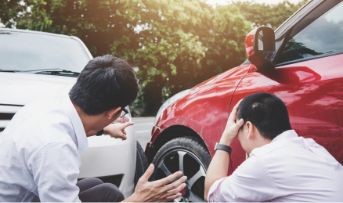
Here's all you need to know about parked car damage and the ways to deal with it
Imagine you park your car in the open and are left surprised when you find it crashed. Parking damage refers to the damage caused to your parked car by an unknown person. You should know what to do if someone hits your parked car.
This article tells you what to do when someone damages your parked car. Additionally, it is advisable to buy car insurance online to protect your vehicle from unexpected damage.
Who pays for parking damages?
If a known person with a liability car insurance policy hits your parked car, their insurance company will pay for your damage. But if a stranger or unknown person hits your car, your car insurance company will pay for the parked car damage.
What should you do when someone hits your parked car?
The first thing you should do is to remain calm and alert when you encounter a parked car damage and follow these tips, including:
1. Find the witness to the accident
If you don't see a driver damaging your car, you should look for witnesses to the accident. Try to find the people who were at the accident spot, and once you find them, ask them about the description or details of the vehicle that damaged your car.
2. Note the offender's details
If you see a vehicle that damages your car, write down its details on paper, such as its registration number, colour, model, etc., and store it safely. You'll have to produce all these details at the police station at the time of filing the FIR and insurance claim.
3. Look for a security camera
Generally, parking spaces and market areas have security cameras installed. You can check who slammed your car and use a copy of the footage to claim your car's damage coverage. However, if the parking space has no cameras, look for nearby residences and shops with security cameras.
4. Capture image proof of the accident spot and your damaged car
Take a picture or video of the accident spots and your damaged car, and procure it as evidence of the accident. Insurance companies will approve your claim based on image proofs.
5. Call the police and file an FIR
Report to the police about your parking car damage, as they can help you find the offender. Moreover, if someone gets injured in a parking car accident, calling the police and filing an FIR becomes mandatory.
6. Inform your car insurer about the accident
Once you follow all the above steps, you should notify your car insurance company about the accident. The company will help you cover your car damage by raising a claim.
What to avoid when someone hits your parked car?
Most people make common mistakes when encountering parking damage. Here are the mistakes you should avoid, including:
1. Chasing the offender
Avoid chasing the driver that hit your car before checking for car damages like leaks, brake failure, etc., or any injuries caused to the person inside the car. Check for injuries and seek medical attention if required.
2. Creating chaos
Most people lose their composure and cause chaos by blaming others around the accident spot. Instead, stay calm and capture pictures or videos of accident spots.
3. Sending car for repair
You should avoid sending the car for repair before filing an FIR and informing the insurance company.
Parked car damage is an upsetting accident, but you have to be patient before you take any steps to deal with it. It is better to wait for the person who hit your car to return and complete the accident report together. If not, follow the above tips to get compensation for the damages to your car from your insurer. Whether you have an expensive or leased car, you should get car insurance online to insure it against parking damage, injury to the driver, and theft.
Click HERE to buy car insurance online.
Disclaimer: The information provided above is for illustrative purposes only. To get more details, please refer to policy wordings and prospectus before purchasing a policy.


